

Legendary Lands: Umberto Eco on the Greatest Maps of Imaginary Places and Why They Appeal to Us. By Maria Popova “Often the object of a desire, when desire is transformed into hope, becomes more real than reality itself.”
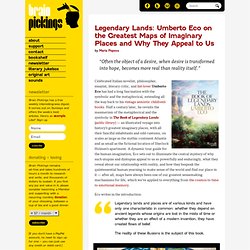
Celebrated Italian novelist, philosopher, essayist, literary critic, and list-lover Umberto Eco has had a long fascination with the symbolic and the metaphorical, extending all the way back to his vintage semiotic children’s books. The World of 100: Our Global Village. By Maria Popova The real minority report, or what the world would look like if it were a village of 100.

From data visualization to infographics, we’re big on the power of smart graphic design to convey big concepts that are otherwise hard to grasp in their raw numberness. Which is why we love designer Toby Ng‘s poster series The World of 100 — an experimental graphical representation of statistical information about the world, based on the allegorical scenario of reducing the world to a village of 100 people. The series is pure design crispness — simple vectors make the shapes clean enough to make their point, with vibrant, solid colors making those points all the more visceral and impactful. Bureaucratics: A Global Portrait of Red Tape. By Maria Popova Unless you’ve lived in a country plagued by the kind of institutional inefficiency characteristic of oppressive political regimes (like we have — hello, motherland), you can never fully appreciate the sometimes comic, often tragic, and invariably debilitating magnitude of red tape.
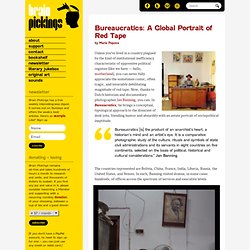
Now, thanks to Dutch historian and documentary photographer Jan Banning, you can: In Bureaucratics, he brings a conceptual, typological approach to the dreariest of desk jobs, blending humor and absurdity with an astute portrait of sociopolitical ineptitude. How to Find Your Purpose and Do What You Love. “Find something more important than you are,” philosopher Dan Dennett once said in discussing the secret of happiness, “and dedicate your life to it.”

But how, exactly, do we find that? Surely, it isn’t by luck. Bark: An Intimate Look at the World's Trees. By Maria Popova Tree bark may not sound like the most exciting or relatable of subjects but, in fact, it is both.

Not only do we come in contact with it constantly in our daily lives, from cinnamon to cork to chewing gum to rubber, but it’s also a hauntingly beautiful, textured piece of living matter that looks like the skin of some magnificent mythical dragon. French photographer Cedric Pollet travels the world to capture this beauty and has documented it in his gorgeous new book, Bark: An Intimate Look at the World’s Trees. To whet people’s enthusiasm, I thought it was important to find ways to surprise and move them, by treating bark in a completely new way, at once aesthetic and playful.” ~ Cedric Pollet. Make Good Art: Neil Gaiman's advice on the creative life, adapted by design legend Chip Kidd. By Maria Popova “Make New Mistakes.
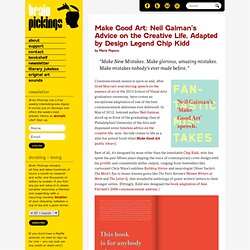
Make glorious, amazing mistakes. Make mistakes nobody’s ever made before.” Commencement season is upon us and, after Greil Marcus’s soul-stirring speech on the essence of art at the 2013 School of Visual Arts graduation ceremony, here comes an exceptional adaptation of one of the best commencement addresses ever delivered: In May of 2012, beloved author Neil Gaiman stood up in front of the graduating class at Philadelphia’s University of the Arts and dispensed some timeless advice on the creative life; now, his talk comes to life as a slim but potent book titled Make Good Art (public library).
When things get tough, this is what you should do: Make good art. A wise woman once said, “If you are not making mistakes, you’re not taking enough risks.” Revisit the talk in its original delivery below, and reabsorb its eight indispensable lessons: Donating = Loving Bringing you (ad-free) Brain Pickings takes hundreds of hours each month. Talk to Me: Design and the Communication Between People and Objects. By Maria Popova The ever-expanding definition and cultural role of design in the age of sensors, data, and responsive interfaces.
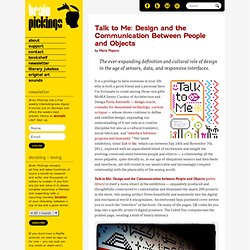
It is a privilege to have someone in your life who is both a good friend and a personal hero. I’m fortunate to count among those rare gifts MoMA Senior Curator of Architecture and Design Paola Antonelli — design oracle, crusader for humanized technology, curious octopus — whose shows continue to define and redefine design, expanding our understanding of it not only as a creative discipline but also as a cultural translator, social lubricant, and “interface between progress and humanity.” Talk to Me: Design and the Communication between People and Objects (public library) is itself a meta-object in the exhibition — exquisitely produced and thoughtfully constructed to contextualize and illuminate the nearly 200 projects in the show, this analog artifact flows beautifully and seamlessly into the digital and mechanical world it encapsulates.
Tio (2009) Taming The Trolls: Vi Hart on How to Deal With Negative Comments. You Are Stardust: Teaching kids about the whimsy of the universe in stunning illustrated dioramas. By Maria Popova “Every tiny atom in your body came from a star that exploded long before you were born.”

“Everyone you know, everyone you ever heard of, every human being who ever was … lived there — on a mote of dust suspended in a sunbeam,” Carl Sagan famously marveled in his poetic Pale Blue Dot monologue, titled after the iconic 1990 photograph of Earth. The stardust metaphor for our interconnection with the cosmos soon permeated popular culture and became a vehicle for the allure of space exploration. There’s something at once incredibly empowering and incredibly humbling in knowing that the flame in your fireplace came from the sun. A Peek Inside the Notebooks of Great Creators, from Architecture to Advertising to Street Art. By Maria Popova What Brazil’s favelas have to do with field science and Milton Glaser’s creative process.
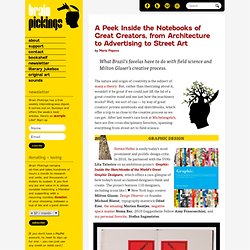
The nature and origin of creativity is the subject of many a theory. But, rather than theorizing about it, wouldn’t it be great if we could just lift the lid of a great creative mind and see just how the machinery works? Well, we sort of can — by way of great creators’ private notebooks and sketchbooks, which offer a trip to as close to the creative process as we can get. After last week’s rare look at Michelangelo’s, here are five cross-disciplinary favorites, spanning everything from street art to field science.
Cartographies of Time: A Visual History of the Timeline. By Maria Popova A chronology of one of our most inescapable metaphors, or what Macbeth has to do with Galileo.

I was recently asked to select my all-time favorite books for the lovely Ideal Bookshelf project by The Paris Review’s Thessaly la Force and artist Jane Mount. Remembering Aaron Swartz: David Foster Wallace on the Meaning of Life. By Maria Popova “Worship your intellect, being seen as smart — you will end up feeling stupid, a fraud, always on the verge of being found out.” This past weekend, I attended the heartbreaking memorial for open-access activist Aaron Swartz, who for the past two years had been relentlessly and unscrupulously prosecuted for making academic journal articles freely available online and who had taken his own life a week prior. A speaker at the service read a piece by one of Aaron’s personal heroes, David Foster Wallace — an excerpt from Wallace’s famous Kenyon College commencement address, the only public talk he ever gave on his views of life, which was eventually adapted into a slim book titled This Is Water: Some Thoughts, Delivered on a Significant Occasion, about Living a Compassionate Life (public library).
If you worship money and things — if they are where you tap real meaning in life — then you will never have enough. Never feel you have enough. Donating = Loving Share on Tumblr. Afterwords: Moving Letters of Condolence on Virginia Woolf's Death. By Maria Popova T.S. Eliot, Edith Sitwell, E.M. Clare Boothe Luce's Advice to Her 18-Year-Old Daughter. Bruno Munari on Design as a Bridge Between Art and Life. By Maria Popova “The designer of today re-establishes the long-lost contact between art and the public, between living people and art as a living thing.”
In the preface to his 1966 classic Design as Art (public library) — one of the most important and influential design books ever published — legendary Italian graphic designer Bruno Munari, once described by Picasso as “the new Leonardo,” makes a passionate case for democratizing art and making design the lubricant between romanticism and pragmatism. Dreamland: What Happens While You Sleep and How It Affects Your Every Waking Moment. By Maria Popova “We are living in an age when sleep is more comfortable than ever and yet more elusive.” The Ancient Greeks believed that one fell asleep when the brain filled with blood and awakened once it drained back out. Nineteenth-century philosophers contended that sleep happened when the brain was emptied of ambitions and stimulating thoughts. “If sleep doesn’t serve an absolutely vital function, it is the greatest mistake evolution ever made,” biologist Allan Rechtschaffen once remarked. How to Find Your Purpose and Do What You Love. Venus with Biceps: A Pictorial History of Muscular Women.
By Maria Popova Exploring gender identity and cultural disposition through rare archival images from 1800-1980. Neurologist Oliver Sacks on memory, plagiarism, and the necessary forgettings of creativity. This Explains Everything: 192 Thinkers Each Select the Most Elegant Explanation of How the World Works. Goethe on the Psychology of Color and Emotion. The science of love: How "positivity resonance" shapes the way we connect. How to Be an Explorer of the World. By Maria Popova “Every morning when we wake up, we have twenty-four brand-new hours to live. Doyald Young: The Self-Made Typography Icon in His Own Words.
How to Give a Great Presentation: Timeless Advice from a Legendary Adman, 1981. 100 Diagrams That Changed the World. How to Avoid Work: A 1949 Guide to Doing What You Love. C. S. Lewis's Advice to Children on Duty and the Three Kinds of Things Anyone Need Ever Do.